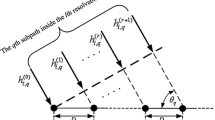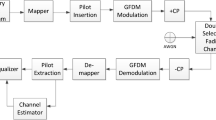Abstract
In this paper, an accurate and computationally efficient algorithm is proposed for estimating time-varying and frequency-selective fading channel with unequally spaced pilot symbols. By employing the time-varying coefficient polynomial interpolation method, it is proved that the time-varying channel impulse response can be estimated by the product of a constant matrix and the fading information at pilot symbol positions. Furthermore, a least square off-line training algorithm is presented to optimally calculate the constant matrix, taking into consideration of the statistics of channel fading and noise. The new algorithm can also be applied for estimating flat fading channel with equally spaced pilot symbols as a special case. Simulation results indicate that our new channel estimation algorithm leads to small mean square error for fading estimation and provides bit error rate performance close to that of the perfect channel estimation.
Similar content being viewed by others
REFERENCES
J. G. Proakis, Digital Communication, 4th ed. McGraw-Hill, Boston, MA, 2001.
A. Aghamohammadi, H. Meyr, and G. Asheid, A new method for phase synchronization and automatic gain control of linearly modulated signals on frequency-flat fading channels, IEEE Transaction Communication, Vol. 39, pp. 25–29, 1991.
J. K. Cavers, An analysis of pilot symbol assisted modulation for Rayleigh fading channels, IEEE Transaction Vehicular Technology, Vol. 40, pp. 686–693, 1991.
G. T. Irvine and P. J. McLane, Symbol-aided plus decisiondirected reception for PSK/TCM modulation on shadowed mobile satellite fading channels, IEEE Journal Selected Areas Communication, Vol. 10, pp. 1289–1299, 1992.
S. Sampei and T. Sunaga, Rayleigh fading compensation for QAM in land mobile radio communication, IEEE Transaction Vehicular Technology, Vol. 42, pp. 137–147, 1993.
A. N. D'Andrea, A. Diglio, and U. Mengali, Symbol-aided channel estimation with nonselective rayleigh fading channels, IEEE Transaction Vehicular Technology, Vol. 44, pp. 41–48, 1995.
A. Mammela and V.-P. Kaasila, Smoothing and interpolation in a pilot-symbol assisted diversity system, International Journal of Wireless Information Networks, Vol. 4, pp. 205–214, 1997.
C. Xiao and J. C. Oliver, Nonselective fading channel estimation with non-uniformly spaced pilot symbols, International Journal of Wireless Information Networks, Vol. 7, pp. 177–185, 2000.
D.-Z. Liu and C.-H. Wei, Channel estimation and compensation for preamble-assisted DAPSK transmission in digital mobile radio system, IEEE Transaction Communication, Vol. 50, pp. 546–556, 2001.
P. A. Bello, Characterization of randomly time-variant linear channels, IEEE Transaction Communication System, Vol. CS-11, pp. 360–393, 1963.
J. D. Parsons, The Mobile Radio Propagation Channel, 2nd ed. Wiley, 2000.
TIA Technical Sub-Committee TR-45.3, TIA/EIA-136-131-A Draft Text: Digital Traffic Channel Layer 1, Nov. 1998.
TESI. Tdoc SMG2 95/97, Enhanced Data rate for GSM Evolution (EDGE) Feasibility Study, Work Item 184; Improved Data Rates through Optimized Modulation, version 0.3, Dec. 1997.
UMTS, Selection procedure for the choice of radio transmission technologies of UMTS, UMTS 30.03 version 3.2.0 ETSI, Apr. 1998.
L. Scharf, Statistical Signal Processing, Prentice Hall, 1991.
F. Rotella, Improvements on derivatives of matrices, Journal of Franklin Institution, Vol. 328, pp. 487–503, 1991.
W. C. Jakes, Microwave Mobile Communications, Piscataway, NJ: IEEE Press, 1994.
A. Duel-Hallen and C. Heegards, Delayed decision-feedback sequence estimation, IEEE Transaction Communication, Vol. 37, pp. 428–436, 1989.
V. M. Eyuboglu and S. U. Quereshi, Reduced-state sequence estimation with set partitioning and decision feedback, IEEE Transaction Communication, Vol. 36, pp. 13–20, 1988.
F. Adachi, Reduced state transition viterbi differential detection of M-ary DPSK signals, Electronics Letters, Vol. 32, pp. 1064–1066, 1996.
S. Chennakeshu and G. J. Saulnier, Differential Detection of π/4-shifted-DQPSK for digital cellular radio, IEEE Transaction Vehicular Technology, Vol. 42, pp. 46–57, 1993.
V. Fung, T. S. Rappaport, and B. Thoma, Bit error simulation for π/4 DQPSK mobile radio communications using two-ray and measurement-based impulse response models, IEEE Journal Selected Areas Communication, Vol. 11, pp. 393–405, 1993.
Y. R. Zheng and C. Xiao, Improved models for the generation of multiple uncorrelated rayleigh fading waveforms, IEEE Communication Letters, Vol. 6, pp. 256–258, 2002.
J. K. Tugnait and T. Li, A multistep linear prediction approach to blind asynchronous CDMA channel estimation and equalization, IEEE Journal Selected Areas Communication, Vol. 19, pp. 1090–1102, 2001.
L. B. Lopes, Performance of Viterbi equalisers for the GSM system, IEE National Conference Telecommunication, pp. 61–65, York, 1989.
Rights and permissions
About this article
Cite this article
Wu, J., Xiao, C. & Olivier, J.C. Time-Varying and Frequency-Selective Channel Estimation with Unequally Spaced Pilot Symbols. International Journal of Wireless Information Networks 11, 93–104 (2004). https://doi.org/10.1023/B:IJWI.0000034541.89020.70
Issue Date:
DOI: https://doi.org/10.1023/B:IJWI.0000034541.89020.70




